


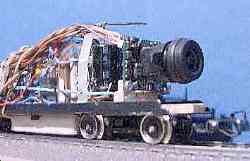
The video locomotive consists - beside the locomotive - of two main components: The transmitter and the camera. The latter is usually given too little attention - with the result of extremely modest pictures. In addition a power supply is required: In a digital world we have it simple - there are already sufficient cameras with 5V and 12V operating voltages. Conventional voltage regulators of the 78xx - series together with wiring heat sink for the voltage regulator and a large capacitor to smooth out the voltage are required. For the hobbyist who wants it all a microphone together with preamplifier can also be installed to allow the audience to hear what is happening around the layout.
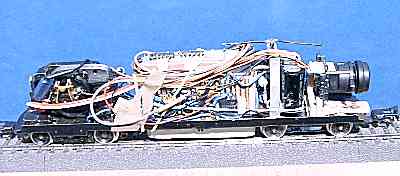 With the transmitter there are two possibilities: One can take and cannibalize a low-priced complete set. That is the cheapest way - approx. DM 200, - - it has however due to the size of the transmitter module only certain locomotives are possible such as Märklin's V200 and an invisible accommodation of the camera therefore is usually not possible. I will describe this in more detail at a later time - presently my prototype will not be displayed on my website.
With the transmitter there are two possibilities: One can take and cannibalize a low-priced complete set. That is the cheapest way - approx. DM 200, - - it has however due to the size of the transmitter module only certain locomotives are possible such as Märklin's V200 and an invisible accommodation of the camera therefore is usually not possible. I will describe this in more detail at a later time - presently my prototype will not be displayed on my website.
The other possibility is to purchase smaller but more expensive OEM transmitter module together with a separate and suitable receiver. This option usually costs approx. DM 450, however this option has the advantage of also allowing "flatten" locomotives and control cars to be used to house the equipment. If the camera is small enough possibly everything could be completely mounted inside an existing locomotive without much modification.
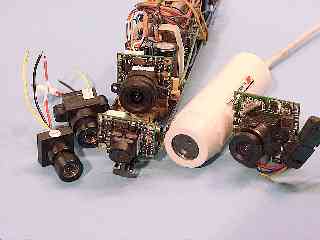 Through extensive research of more than a dozen colour cameras which were small enough to fit into a locomotive, it has been very difficult to find a camera that was small enough (max board size 30mm) and good enough to capture high quality images in varying levels of light. CMOS cameras were the worst of the bunch giving poor picture quality and requiring a higher level of light to capture an image. Some CCD cameras were overly expensive and did not give desirable results. In the end I ended up going with an OEM CCD colour camera similar in size as a CMOS camera 26mm x 22mm and still use a 5V power source. But instead of further long discussion I will let the pictures speak for themselves (click on the pictures below to enlarge to 640x480):
Through extensive research of more than a dozen colour cameras which were small enough to fit into a locomotive, it has been very difficult to find a camera that was small enough (max board size 30mm) and good enough to capture high quality images in varying levels of light. CMOS cameras were the worst of the bunch giving poor picture quality and requiring a higher level of light to capture an image. Some CCD cameras were overly expensive and did not give desirable results. In the end I ended up going with an OEM CCD colour camera similar in size as a CMOS camera 26mm x 22mm and still use a 5V power source. But instead of further long discussion I will let the pictures speak for themselves (click on the pictures below to enlarge to 640x480):
.
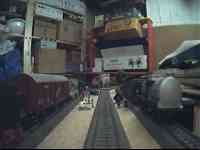 A typical picture of a CMOS camera.
A typical picture of a CMOS camera.
Grainy picture quality, in a diffuse way, faintly.
A comment is unnecessary.
.
.
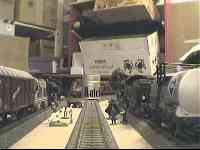 The Märklin video wagon - CCD, but with needle eye objective.
The Märklin video wagon - CCD, but with needle eye objective.
The CCD-Camera is actually quite good - only the needle-eye-
objective worsens the image quality quite substantially, which
becomes strongly apparent particularly with bad light.
.
.
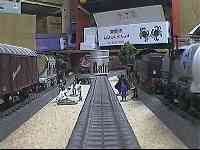 The above mentionded OEM-CCD - camera,
The above mentionded OEM-CCD - camera,
which I can recommend without reservation.
.
.
.
I adjusted the lenses of the cameras in such a way that camera will focus at close range, the "Matches" - box and the streamline locomotive at a distance of approx. 60 are recognizable behind it are illustrated sharply even at 70 cm. The scene in the foreground is in a distance of approx. 25 - 35 cm. The lighting consists of two 38W full spectrum lights - it prevails thus a normal model course.
The pictures of the camera are transmitted to a receiver module approx. 6 m away by a wall and then captured with a Frame grabber video card (such as the type from Elsa Gloria Synergy digitizer). The fixed images were then captured by using the software GIOTTO from Georg Dittié, actually his software was intended for video astronomy but I was able to optimize it and in each case 100 fixed images were digitized and added; this eliminates the fixed image noise. A moderate sharpness filter eliminated the blurring of the picture addition. The result speaks for itself.
 On a suggestion of A HREF="MAILTO:"Stefan.Sczekalla@gmx.de">Stefan Sczekalla-Waldschmidt now still 60 seconds are enough for "sample" - taken up with my prototype, the OEM-CCD in the chassis of a V200 from Märklin. Although I tried to keep the file size small this resulted in only a modest picture quality (160x120, 10 pictures/s, only approx. 3k for each picture, no sound). I also have it in zip format nevertheless still 1.8 MB in size (perhaps someone would like to make to files smaller without further loss to the picture quality are more than welcome to). In order to judge, whether the Download is worthwhile just click on the small picture to see a small digitalized excerpt. The result speaks for itself.
On a suggestion of A HREF="MAILTO:"Stefan.Sczekalla@gmx.de">Stefan Sczekalla-Waldschmidt now still 60 seconds are enough for "sample" - taken up with my prototype, the OEM-CCD in the chassis of a V200 from Märklin. Although I tried to keep the file size small this resulted in only a modest picture quality (160x120, 10 pictures/s, only approx. 3k for each picture, no sound). I also have it in zip format nevertheless still 1.8 MB in size (perhaps someone would like to make to files smaller without further loss to the picture quality are more than welcome to). In order to judge, whether the Download is worthwhile just click on the small picture to see a small digitalized excerpt. The result speaks for itself.

